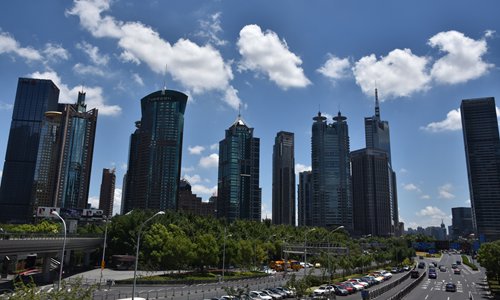HOME >> OPINION
Tale of Cities: Similarity breeds contempt
By Rong Xiaoqing Source:Global Times Published: 2019/8/1 20:23:31

Photo: IC
I took a short trip to China earlier this summer and visited several cities, including some I had never been to, which to a curious person like myself, never fails to evoke excitement and anticipation. But during this trip, I found my moods on a roller coaster - every time the enthusiasm levels built up as I took a high-speed train, they deflated on arrival at the destination.
The cities I had never been to all looked far too familiar. The high-rise commercial and residential buildings lining up both sides of the streets, the international designer brand stores clustered around downtown, the domestic chains peppering the food zone, and the propaganda banners screaming messages of unity in all public areas. Nothing I saw appeared original.
Sometimes, disappointment hit even while the train was pulling into the station, especially when it was the station of my hometown. The layout of the newly-built train station and the skyline outside failed to arouse me to homecoming. Yet I couldn't say they looked unfamiliar - they were almost identical to those I had seen in many other cities.
The only places that consoled my confused soul were a residential neighborhood in Yantai, East China's Shandong Province, where vendors squatted at the curbside to sell a rich variety of food from tomatoes and cucumbers to live seafood, and a decades old food stand in Wuhan, Central China's Hubei Province that offered a delicious local snack and boasted on the sign board that it had no franchise. But while street food vendors nationwide are being driven into indoor markets with identical glistening booths, and owners of mom and pop shops are aging and their children show little interest in taking over the businesses, I wondered how long these typical places could last.
This was not the first time I realized that it had been getting difficult to distinguish cities in China. It's a process that has been advancing day by day in at least the last decade. But now it seems the process of cloning is almost complete and may be irreversible.
Identical cities are not by any means unique to China. The development of materials and building technology after WWII began to squeeze the unique local character out of architecture in developed countries by enabling developers to build modern structures without considering the particular climate of a locality.
In the US the needs for housing in the post-war era, triggered by returning veterans and the growing baby boomer generation, had helped launch the urban sprawl in which "cookie cutter produced houses" emerged in suburban areas like bamboo shoots after the rain. And the growth of major chain stores from McDonald's to Walmart in the 60s and 70s created more uniformity of experience across the US, whether in terms of sights, smells or tastes.
Meanwhile, neighborhoods in big cities have over the years often been destroyed by highways piercing through their hearts, splitting them in two, and by enormous buildings stretching over several blocks. In an article in the 1996 Atlantic magazine, James Howard Kunstler summarized the suffocating result: "the fry pits, the big-box stores, the office units, the lube joints, the carpet warehouses, the parking lagoons, the jive plastic townhouse clusters, the uproar of signs, the highway itself clogged with cars - as though the whole thing had been designed by some diabolical force bent on making human beings miserable."
The days when big box stores and mass produced houses grew without restraint are long gone. The painful memories of watching neighborhoods lose their identity have bred a new generation who would fight tooth and nail against the big box stores and bland urban taste. Independent local shops selling anything that's not mass produced became popular.
Ironically, though, it doesn't attenuate the encroachment of sameness but only helps it evolve. Last year, New York magazine published an essay by Oriana Schwindt - "The Unbearable Sameness of Cities" that talked about the author's experience of travelling around the country only to find even the independent local shops copying one another's coolness and offering the same décor and even similar-looking "young and tattooed and bespectacled" customers. "The establishments weren't chains... Why did they all seem plucked from some gentrifying corner of Brooklyn?" Schwindt asked.
Different eras, same problem. Still it took decades in the US to get to the sameness 2.0. In China, when the standardized subway and high speed railroad systems and identical skyscrapers have sprawled all over the country, pedestrianized streets covered in red lanterns and populated with small stores selling "handmade" crafts are also being built in every city. In a country that has made the world sit up and admire the speed of its development, the two versions of sameness are happening at the same time.
Maybe it's just one of the downsides of modern society - it is basically market oriented and leans toward efficiency so that replication is inevitable. Still, I cannot help wonder what a toll the sameness of cities will take on our souls. Maybe I'll have to wait until sameness 3.0 is here to find the answer.
The author is a New York-based journalist and Alicia Patterson fellow. rong_xiaoqing@hotmail.com
Posted in: VIEWPOINT